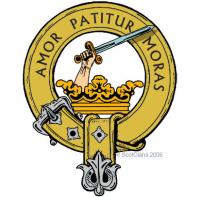
Clan Lumsden
The name Lumsden is of territorial origin, deriving from Lumsden, an old manor in the parish of Coldingham, Berwickshire. Brothers Gillem (William) and Cren de Lumsden were witnesses to a charter by Waldeve, Earl of Dunbar, to the Priory of Coldingham between 1166 and 1182. This is the earliest known recording of the surname Lumsden. However, the first mention of the lands of Lumsden comes from a charter from the end of the 11th century by King Edgar of Scotland in 1098. The first recorded owners of the land are Gillem and his brother Cren.
Many Scottish nobles and clan leaders were forced to pay homage to England’s Edward I by signing the Ragman Rolls in 1296. There are two Lumsdens (or Lummefdens as it was spelled) on this list: Adam de Lummefden and Rogier de Lummefden.
In 1329 Gillbert de Lumsden was given a charter by the Earl of Angus for the lands of Blanerne, after having married the heiress of Blanerne the previous year, in 1328.
By the mid 1300s branches of the Lumsden clan had charters and lands confirmed to them in a number of places up and down the east coast of Scotland, including Conlan in Fife, and Medlar and Cushnie in Aberdeenshire.
During the Thirty Years' War (1618-1648) members of Clan Lumsden fought for the Swedish King Gustavus Adolphus. Their unit was called "Lumsden's Musketeers".
James Lumsden and his men returned to Scotland from the war in Europe to fight on the side of the Covenanters in the Civil War, which was taking place all over the British Isles. They fought at the 1644 Battle of Marston Moor in Yorkshire under Alexander Leslie, Earl of Leven, which saw a heavy defeat for the Royalist army of Charles I. They also fought at the Battle of Dunbar in 1650, this time under David Leslie where Oliver Cromwell’s Parliamentarians defeated them.
Robert Lumsden, brother of James, helped to defend Dundee against General Monck, but he was killed on its surrender.
The Chief of Clan Lumsden was secretary to Bonnie Prince Charlie during the 1745 Jacobite Rebellion. After the Battle of Culloden in 1746 the chief fled to Rome. On his return to Scotland in 1773 the British government pardoned him for his role in the uprising. At Pitcaple Castle near Inverurie, the chief’s tartan waistcoat is preserved.






